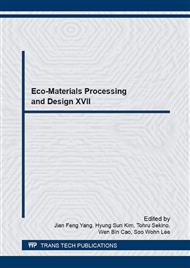p.68
p.73
p.79
p.84
p.89
p.95
p.100
p.105
p.111
Influence of Heater Diameter on the Temperature Distribution and Melt Convection in a Directional Solidification System for Mono-Like Silicon Growth
Abstract:
Mono-like silicon is one of the promising alternative wafer materials compared with mono-crystalline silicon and multi-crystalline silicon due to its relatively higher conversion efficiency and lower production cost. But there is still a large room to improve the crystal quality and to reduce the manufacturing cost, which could push the wafers into photovoltaic industry practically. In this paper, the CGSim software has been employed to analyze the influence of heater diameter on the temperature distribution and melt convection in a mono-like silicon lab-scale growth system. The results showed that the power consumption of the furnace was decreased from 65.2KW to 52.8KW as decreasing the heater diameter. It is mainly caused by the improved heating efficiency of resistance heater. At the same time the average melt temperature and temperature difference along axial direction as well as along melt free surface were increased with decreasing the heater diameter, resulting in a change of melt convection behavior. Consequently, the shape and fluctuation of solid-liquid interface changed due to various convection intensity and temperature difference. Thus, aiming at decreasing product cost and improving wafer quality, the optimized distance between heater and graphite crucible for mono-like silicon growth system could be determined as 20mm.
Info:
Periodical:
Pages:
100-104
Citation:
Online since:
August 2016
Authors:
Price:
Сopyright:
© 2016 Trans Tech Publications Ltd. All Rights Reserved
Share:
Citation:


